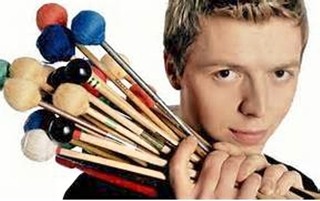|
Back
Brassy Slide-of-Hand Versus Percussive Conjuring New York
David Geffen Hall, Lincoln Center
06/10/2016 -
William Bolcom: Trombone Concerto (World Premiere)
John Corigliano: Conjurer: Concerto for Percussionist and String Orchestra and Brass (New York Premiere)
Joseph Alessi (Trombone), Martin Grubinger (Percussion)
New York Philharmonic Orchestra, Alan Gilbert (Conductor)

M. Grubinger (© Felix Broede)
Tar and feather me if you so desire. For I confess my total ignorance that this was Trombone Week in New York City. Neither blushing nor confessing nor genuflecting makes up for my sin.
Thus, it was no surprise that the New York Phil Biennial concert last night was packed, with every seat in the Orchestra section taken by the most unlikely enthusiastic crowds. Proudly donning their Trombone Association name cards, the international association of trombone players, duly saluted by conductor Alan Gilbert, was immortalized in another way by the world premiere of a trombone concerto by a world-famous composer.
And yes, William Bolcom was on stage with Mr. Gilbert to discuss his Trombone Concert, how it celebrated the most eclectic history of the instrument, and how it also was to celebrated the NY Phil’s own First Chair player, Joseph Alessi.
Like much of Mr. Bolcom’s music, this merged a serious technical exposition with a (usually) light-hearted look at music. His opera View From The Bridge is an exception. For much of his achievement, and all of his piano music, transcends popular music, yet keeps the American traditions alive.
The Trombone Concerto, though, gave credit to the medieval trombone tradition, with some mystical, virtuosic lines which obviously reflected the Gabrielli brass-choir anthems from Venice’s St. Mark’s Cathedral. It was not an easy movement to apprehend, but showed Mr. Alessi’s deft hand at a more esoteric music. The Blues section was hardly orthodox, but had the swing of his ragtime music. The lines of a master. Finally, Charade was jazzy, relaxed and gave Mr. Alessi the pinpoint accuracy of his instrument. No tricky trombone effects (only the mutes), but an orthodox difficult essay for this fine instrumentalist.
The other New York Phil premiere, Conjurer: Concerto For Percussionist and String Orchestra and Brass was introduced by John Corigliano and performed–shall we say summoned up from heaven and hell?–by an Austrian percussionist of wizardly talents.
Not that the composer knew about percussion to begin with. Mr. Corigliano confessed to hating the idea of a percussion concerto. (No tuned instruments, no way to balance out percussion with orchestra etc etc), but after experimenting with a variety of instruments at Juilliard, he wrote a work, originally for Evelyn Glennie, that was played by Martin Grubinger as though he was an instrument himself.
The name and movements were Corigliano’s way to solve the musical problems. Adding “And Brass” to the title was a way to make the strings sound over the percussion. (The brass was actually optional, but really did accentuate the music.) The movements, Wood, Metal and Skin with cadenzas before each, was to solve the physical problems of having the artist run around the stage. The xylophone family, the tubular bells and vibraphones, and the African talking-drums and kettle drums etc were separated on the stage.
Thus, Mr. Grubinger was able to create all his wondrous sounds and nuances without sprinting about.
The outer movements were glorious, exactly as one would expect with hands as consummate as Mr. Grubinger. In fact, for sheer intrigue, one couldn’t best the climax, where he used elbows, fingers and arms to make his kick-drums, tom-toms, congas, bass drum and timpani, bounce, resonate and make conversation with the orchestra, all the way up to the semi-improvised thunderous finale.
But Mr. Corigliano had no intention of making a simple piece to show off a great virtuoso. His second movement started with a clash for bells, tam-tams and cymbals. And abruptly, the strings started a lament that sounded like the Barber Adagio or like any number of slow songs from American composers. It was touching, desolate, and Mr. Grubinger, in the lowest register of the vibraphone, gave it the feeling not of a dazzlingly skilled player but an exutant of truly momentous music.
One has the feeling that if Mr. Corigliano arranges this Metal movement for orchestra and any solo instrument–Harmonica? Kazoo? Jew’s Harp? Mr. Alessi’s trombone?–it would show the same inspired music from a most inspired composer.
Harry Rolnick
|